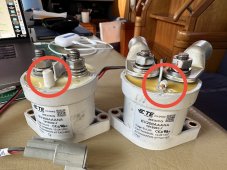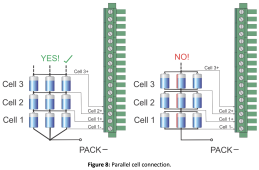BillCaswell
New Member
- Joined
- Jan 10, 2020
- Messages
- 78
Hello All,
- I am swimming in the amount of information available on this forum that I've been reading for the past few weeks.
- I have some gaps in my thinking that I need to close.
- I am planning a 96 cell installation in my sailboat organized into 4 battery packs of 24 Fortune 100ah cells 2C (6C peak, 10 sec) arranged as 3P8S to provide 24 volts to the house system. (see the enclosed picture)
- I do not want to cut corners. This build needs to be bullet proof using the most reliable and safest components I can source.
- The rest of electrical system is Victron Energy.
96 cells divided into 24 cells in a 3P8S configuration to provide 24 volts
4 x battery packs to create the house bank
3P gives me 600 amps continuous at 24v
The house bank is also used the drive 20 hp (14 kW) electro-hydraulic bow thruster motor. It draws 700 amps. It is used sporadically 3-10 seconds at a time. The specs on the Fortune cells appear to be the best fit.
I believe that this requires that I use a contractor
I am overwhelmed by the discussions regarding the best BMS to focus my attention on. REC, Batrium, Chargery and Electrodacus, and Orion, etc.
Questions:
- Does my application of the 3P8S packs x 4 house bank configuration make is it obvious to others which BMS to look at as a first, second and third choice?
- Will I be attaching a BMS lead to each cell or one lead per each 3P group?
- Do I need a master-slave BMS to manage all four packs that make up the house bank, or do I treat each battery pack as independently managed by their own BMS without any communications between each battery?
Thanks in advance for any insights you can provide!

- I am swimming in the amount of information available on this forum that I've been reading for the past few weeks.
- I have some gaps in my thinking that I need to close.
- I am planning a 96 cell installation in my sailboat organized into 4 battery packs of 24 Fortune 100ah cells 2C (6C peak, 10 sec) arranged as 3P8S to provide 24 volts to the house system. (see the enclosed picture)
- I do not want to cut corners. This build needs to be bullet proof using the most reliable and safest components I can source.
- The rest of electrical system is Victron Energy.
96 cells divided into 24 cells in a 3P8S configuration to provide 24 volts
4 x battery packs to create the house bank
3P gives me 600 amps continuous at 24v
The house bank is also used the drive 20 hp (14 kW) electro-hydraulic bow thruster motor. It draws 700 amps. It is used sporadically 3-10 seconds at a time. The specs on the Fortune cells appear to be the best fit.
I believe that this requires that I use a contractor
I am overwhelmed by the discussions regarding the best BMS to focus my attention on. REC, Batrium, Chargery and Electrodacus, and Orion, etc.
Questions:
- Does my application of the 3P8S packs x 4 house bank configuration make is it obvious to others which BMS to look at as a first, second and third choice?
- Will I be attaching a BMS lead to each cell or one lead per each 3P group?
- Do I need a master-slave BMS to manage all four packs that make up the house bank, or do I treat each battery pack as independently managed by their own BMS without any communications between each battery?
Thanks in advance for any insights you can provide!

Last edited:




